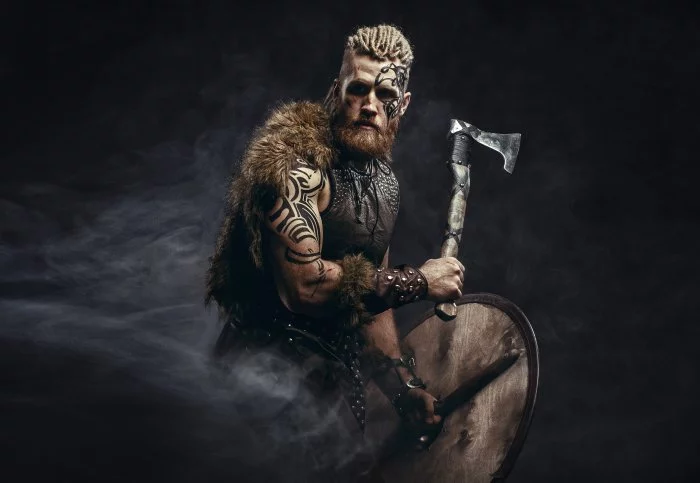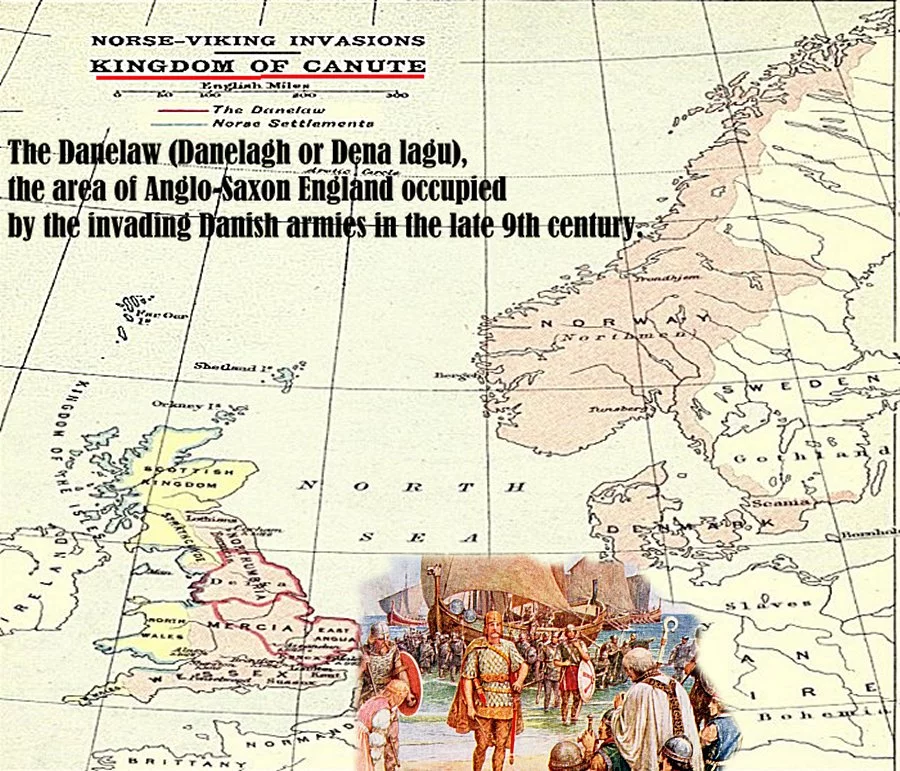Vast DNA Analysis of Hundreds of Vikings Reveals They Weren’t Who We Thought
A fascinating DNA study of more than 400 Viking skeletons has just re-written history. Today we know with certainty some Vikings were not those who we previously thought.

A Viking warrior.
Scientists have examined skeletons scattered across Europe and Greenland and cutting-edge DNA sequencing sheds new light on the history of Vikings.
The results of the six-year research project led by Professor Eske Willerslev, a Fellow of St John’s College, University of Cambridge, and director of The Lundbeck Foundation GeoGenetics Centre, University of Copenhagen reveals:
Skeletons from famous Viking burial sites in Scotland were actually local people who could have taken on Viking identities and were buried as Vikings.
- Many Vikings actually had brown hair not blonde hair.
- Viking identity was not limited to people with Scandinavian genetic ancestry. The study shows the genetic history of Scandinavia was influenced by foreign genes from Asia and Southern Europe before the Viking Age.
- Early Viking Age raiding parties were an activity for locals and included close family members.
- The genetic legacy in the UK has left the population with up to six percent Viking DNA.
“We have this image of well-connected Vikings mixing with each other, trading and going on raiding parties to fight Kings across Europe because this is what we see on television and read in books—but genetically we have shown for the first time that it wasn’t that kind of world.
Our Perception Of Vikings Have Changed
This study changes the perception of who a Viking actually was—no one could have predicted these significant gene flows into Scandinavia from Southern Europe and Asia happened before and during the Viking Age,” Professor Eske Willerslev said in a press statement.
The word Viking comes from the Scandinavian term ‘vikingr’ meaning ‘pirate’. The Viking Age generally refers to the period from AD800, a few years after the earliest recorded raid, until the 1050s, a few years before the Norman Conquest of England in 1066.
 Norse-Viking invasions – Kingdom of Canute – Cnut The Great was England’s Danish King and ruler of one Of the largest Nordic Empires
Norse-Viking invasions – Kingdom of Canute – Cnut The Great was England’s Danish King and ruler of one Of the largest Nordic Empires
The Vikings changed the political and genetic course of Europe and beyond: Cnut the Great became the King of England, Leif Eriksson is believed to have been the first European to reach North America – 500 years before Christopher Columbus – and Olaf Tryggvason is credited with taking Christianity to Norway.
Many expeditions involved raiding monasteries and cities along the coastal settlements of Europe, but the goal of trading goods like fur, tusks and seal fat was often the more pragmatic aim.
“We didn’t know genetically what they actually looked like until now,” said Willerslev. “We found genetic differences between different Viking populations within Scandinavia which shows Viking groups in the region were far more isolated than previously believed. Our research even debunks the modern image of Vikings with blonde hair as many had brown hair and were influenced by genetic influx from the outside of Scandinavia.”
The international team sequenced the whole genomes of 442 mostly Viking Age men, women, children, and babies from their teeth and petrous bones found in Viking cemeteries. They analyzed the DNA from the remains from a boat burial in Estonia and discovered four Viking brothers died the same day.
The scientists have also revealed male skeletons from a Viking burial site in Orkney, Scotland, were not actually genetically Vikings despite being buried with swords and other Viking memorabilia.
There wasn’t a word for Scandinavia during the Viking Age – that came later. But the study shows that the Vikings from what is now Norway traveled to Ireland, Scotland, Iceland, and Greenland.
The Vikings from what is now Denmark traveled to England. And Vikings from what is now Sweden went to the Baltic countries on their all-male ‘raiding parties’.
“We carried out the largest ever DNA analysis of Viking remains to explore how they fit into the genetic picture of Ancient Europeans before the Viking Age,” said co-first author Dr. Ashot Margaryan from the University of Copenhagen. “The results were startling and some answer long-standing historical questions and confirm previous assumptions that lacked evidence.
“We determined that a Viking raiding party expedition included close family members as we discovered four brothers in one boat burial in Estonia who died the same day. The rest of the occupants of the boat were genetically similar suggesting that they all likely came from a small town or village somewhere in Sweden.”
 A mass grave of around 50 headless Vikings from a site in Dorset, UK. Some of these remains were used for DNA analysis.
A mass grave of around 50 headless Vikings from a site in Dorset, UK. Some of these remains were used for DNA analysis.
DNA from the Viking remains were shotgun sequenced from sites in Greenland, Ukraine, the United Kingdom, Scandinavia, Poland and Russia.
“We found that Vikings weren’t just Scandinavians in their genetic ancestry, as we analyzed genetic influences in their DNA from Southern Europe and Asia which has never been contemplated before,” said co-first author Professor Martin Sikora form the University of Copenhagen.
“Many Vikings have high levels of non-Scandinavian ancestry, both within and outside Scandinavia, which suggest ongoing gene flow across Europe.”
The team’s analysis also found that genetically Pictish people ‘became’ Vikings without genetically mixing with Scandinavians. The Picts were Celtic-speaking people who lived in what is today eastern and northern Scotland during the Late British Iron Age and Early Medieval periods.
“Individuals with two genetically British parents who had Viking burials were found in Orkney and Norway,” said co-first author Dr. Daniel Lawson from the University of Bristol. “This is a different side of the cultural relationship from Viking raiding and pillaging.”
How Vikings Changed Europe
The Viking Age altered the political, cultural, and demographic map of Europe in ways that are still evident today in place names, surnames, and modern genetics.
“Scandinavian diasporas established trade and settlement stretching from the American continent to the Asian steppe,” said co-author Professor Søren Sindbæk from Moesgaard Museum in Denmark.
“They exported ideas, technologies, language, beliefs, and practices and developed new socio-political structures. Importantly our results show that ‘Viking’ identity was not limited to people with Scandinavian genetic ancestry. Two Orkney skeletons who were buried with Viking swords in Viking style graves are genetically similar to present-day Irish and Scottish people and could be the earliest Pictish genomes ever studied.”
 The Vikings were the lords of the oceans. One of the main reasons behind Vikings’ success to reach distant lands lies in their remarkable longships. The Vikings’ ships were the greatest technical and artistic achievement of the European Dark Ages. Without these great ships, the Viking Age would never have happened.
The Vikings were the lords of the oceans. One of the main reasons behind Vikings’ success to reach distant lands lies in their remarkable longships. The Vikings’ ships were the greatest technical and artistic achievement of the European Dark Ages. Without these great ships, the Viking Age would never have happened.
It’s Time To Re-Write History Books
“This is the first time we can take a detailed look at the evolution of variants under natural selection in the last 2,000 years of European history,” said co-first author Professor Fernando Racimo from the University of Copenhagen.
“The Viking genomes allow us to disentangle how selection unfolded before, during and after the Viking movements across Europe, affecting genes associated with important traits like immunity, pigmentation and metabolism. We can also begin to infer the physical appearance of ancient Vikings and compare them to Scandinavians today.”
The genetic legacy of the Viking Age lives on today with six per cent of people of the UK population predicted to have Viking DNA in their genes compared to 10 per cent in Sweden.
“The results change the perception of who a Viking actually was. The history books will need to be updated,” said Willerslev.
Related Post
A shocking documentary proves that mermaids do exist
SHOCKING Revelation: Thuya, Mother of Queen Tiye, Was the Grandmother of Akhenaten and Tutankhamun—What Ancient Egyptian Secrets Did She Leave Behind?
Breaking News: Astonishing Discoveries at Karahan Tepe Confirm an Extraterrestrial Civilization is Hiding on Earth, and NO ONE Knows!
Breaking News: Researchers FINALLY Discover U.S. Navy Flight 19 After 75 Years Lost in the Bermuda Triangle!
NASA’s Secret Investigation: Uncovering the Astonishing Mystery of the UFO Crash on the Mountain!
Explosive UFO Docs LEAKED: Startling Proof That Aliens Ruled Ancient Egypt!